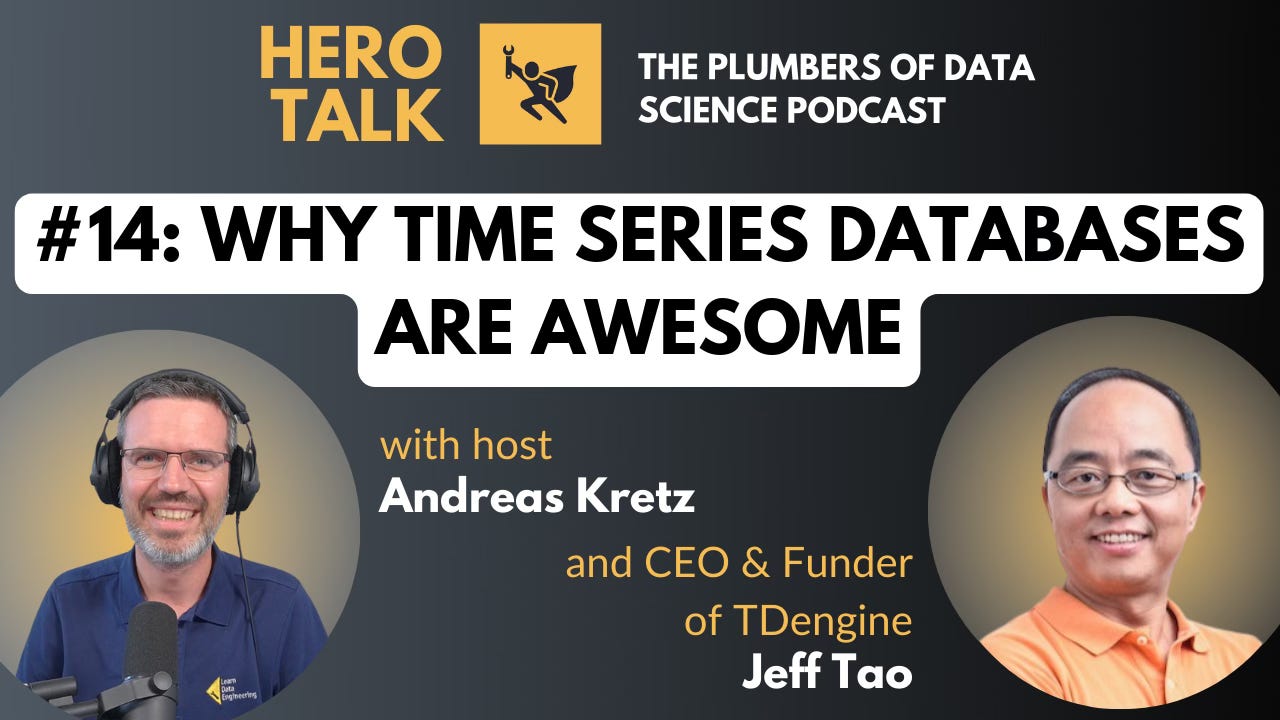The Power of Time Series Databases
Why They’re Essential for Modern Data Management
In today’s data-driven world, not all data is the same. Some data stays still—sitting in rows and columns, waiting to be accessed or analyzed. But then there’s another type of data that is always on the move, changing every second. This is time series data, and it’s becoming more important as our world gets more connected and real-time.
Recently, I had the chance to dive deep into the world of time series databases with Jeff Tao, a seasoned expert in the field as well as CEO and founder of TDengine. Jeff emphasizes that time series data is everywhere. Think of the data streaming from a smart meter in your home, recording your electricity usage every few minutes. Or imagine the sensors on a wind turbine, continuously checking performance. This isn’t just a collection of isolated data points; it’s a continuous stream that needs to be captured, stored, and analyzed in real-time. For this, you need a special tool: a time series database.
Why Traditional Databases Aren’t Enough
You might wonder why we can’t just use traditional databases like MySQL or PostgreSQL for managing time series data. After all, these databases have been around for decades and handle large amounts of data efficiently. However, as Jeff pointed out, time series data comes with its own set of challenges that general-purpose databases struggle to meet.
Performance and Ingestion Rates
One of the main challenges with time series data is the sheer volume and speed at which it’s generated. Jeff explains that traditional databases often can’t keep up with the high ingestion rates required—millions of data points per second are common in time series workloads. Time series databases, on the other hand, are built specifically to handle this massive amount of data, ensuring that your data is stored quickly and is easily accessible when needed.
Specialized Analytics
Time series data isn’t just about storing information; it’s about analyzing it over time. Jeff highlights how tasks like calculating the rate of change, reducing data without losing key details, or applying functions like moving averages are either cumbersome or impossible in traditional databases. Time series databases come equipped with built-in functions designed for these operations, making them far more efficient for time-centric queries.
Handling Out-of-Order Data
In the real world, data doesn’t always arrive in perfect order. Devices can lose connection, and data packets can get delayed, resulting in out-of-order data. Jeff stresses that time series databases are designed to handle this smoothly, ensuring that late-arriving data is properly integrated without disrupting the integrity of your dataset.
Scalability: Meeting the Demands of Big Data
As your data grows, so do the challenges of managing it. With millions of IoT devices each generating streams of data, traditional databases can quickly reach their limits. Jeff notes that time series databases are built to scale horizontally, distributing the workload across multiple servers. This scalability allows them to handle billions of data points effortlessly, making them a perfect solution for industries with large datasets like IoT, finance, or energy.
Retention Policies and Cost Management
Another advantage Jeff points out is the ability of time series databases to manage data retention automatically. Not all data needs to be kept forever—often, older data can be deleted or reduced in size to save storage space. Time series databases can do this automatically, helping to manage storage costs effectively while still retaining the ability to analyze long-term trends.
Simplifying Data Management for Developers and Engineers
Time series databases don’t just improve performance; they also make life easier for developers and data engineers. Jeff highlights how the data model in a time series database naturally fits the way time-based data is collected and queried. This alignment simplifies working with the data, allowing developers to focus on extracting insights rather than wrestling with database structures.
In today’s world, where everything from industrial equipment to smart homes generates continuous streams of data that need to be analyzed in real-time, time series databases are not just a nice-to-have—they’re essential. They provide the performance, scalability, and specialized tools required to turn raw data into useful information.
The Future of Data Management
As our need for real-time data grows, so does the need for databases that can handle it effectively. Time series databases are built specifically for this challenge, offering unmatched performance and scalability. Jeff’s insights make it clear that if your work involves time series data—whether in IoT, finance, energy, or any other field—it’s worth considering a switch to a time series database. The right tool can make all the difference in turning a flood of data into a valuable resource.
Plumbers of Data Science Podcast
By the way, this blog post is based on a Plumbers of Data Science podcast Hero Talk episode. You can watch the complete conversation with Jeff Tao on YouTube here. Or listen to it on all major podcast platforms here.
Best,
Andreas
🍀
Read my free 80+ pages Data Engineering Cookbook on GitHub: Read the Cookbook
Follow me on: LinkedIn | Instagram | X (Twitter) | YouTube |
Learn Data Engineering at my Data Engineering Academy, trusted by over 1,500 students 💪: Click here to learn more



